CNC robotics and automated machining have grown incredibly over the last few years. A major contributing factor to the success of robotics today is its incorporation into manufacturing technologies. One of the most prominent technologies is CNC machining.
Although the roles of CNC machining and robotic machining usually overlap, the lines are increasingly becoming blurry. The implementation of robotics offers incredible advantages to the manufacturing industry. Furthermore, CNC manufacturing robotics is seen as the leading provider of industrial automated solutions.
This article examines the concept of CNC robotics, detailing how companies use this innovation to achieve results. We will discuss the various advantages of CNC manufacturing robotics over conventional methods. Read on to learn more.
What Is CNC Robotics?
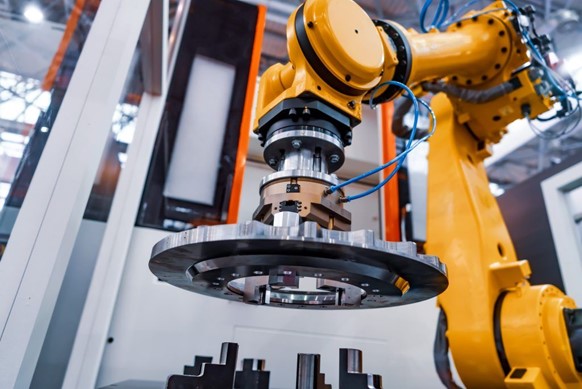
CNC robotics refers to any robotic process that aids the CNC machining process. A CNC robot is any advanced equipment designed solely for machining purposes. Such equipment handles different projects on its own by following programmed protocols. In most cases, these robots do not require any input from an operator.
CNC robotics offers increased automation advantages in manufacturing, ensuring mass production and delivery of high-quality parts for various industries. These CNC machines do not only benefit from robotic implementation; CNC machining applications also involve the manufacture of robot parts.
Why Choose CNC Machining for Producing Robotic Parts?
Asides from the economic benefits of CNC machining for custom robotic applications, there are several crucial reasons for choosing this process to machine a robot. They include the following:
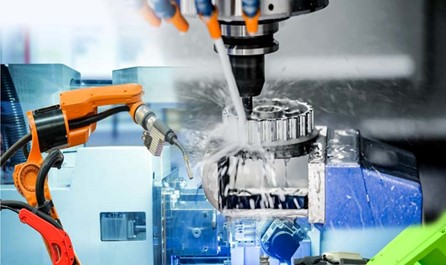
Increased Speed
It is no news that CNC machining can produce components with very short lead times. CNC machines are comparatively faster than many other manufacturing processes. As a result, you can be sure of rapid iterations and delivery of custom robotic parts for various applications. Depending on the complexity and size, CNC machining can create robot parts within 1 to 3 days.
Dimensional Accuracy
CNC machining is also able to create components exactly to specifications. Manufacturing precision is a particularly critical need in robotics, with dimensional accuracy vital for developing high-performing robots. CNC precision machining can produce parts with tight tolerances up to +/- 0.0002 inches. As a result, it can craft robotic components with precise and repeatable movements.
Material Compatibility
Another advantage of CNC machining for robotics is its ability to work with a wide range of metals and plastics. Robot parts must be able to move steadily and lift and transfer objects. As a result, they require strong and stiff materials with a good strength-to-weight ratio. Since CNC machines can work with these types of materials, it is ideal for creating CNC parts for the robotics industry.
Surface Finish
Finally, CNC machining also exerts control over the surface finish of robotic end parts. Interacting robot parts must have low friction, and CNC machines can help create components with a surface roughness of Ra 0.8 μm or lower. Parts made with this manufacturing technique can also undergo additional surface finishing operations to improve their functionality.
CNC Machining And the Robotics Industry
As mentioned earlier, the implementation of robotics and CNC machining overlap. As the manufacturing process benefits from robotic implementation, you can use CNC parts for robotic applications. Here, we’ll look at both angles.
Common CNC Robotic Parts Made with CNC Machining
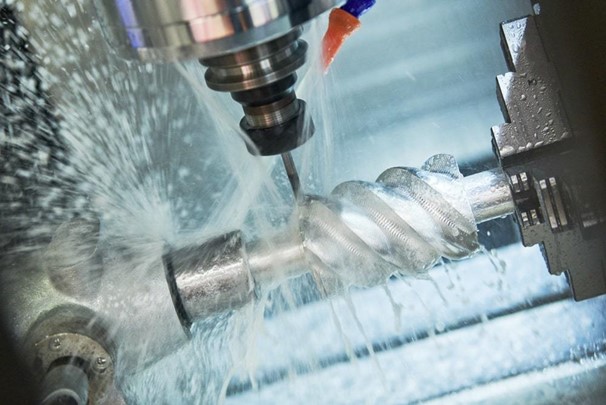
CNC Robotic Arm
These are the vital parts of devices that work like the human arm to perform operations. Although it was initially designed to automate the die casting process, you can now find a CNC robot arm in many devices used in different industries. Since their application is to mainly move objects, their designs involve high-strength materials such as steel, aluminum, and specific plastics.
End Effector
End effectors are devices attached to the end of robotic arms to help the robot perform various tasks and interact with multiple objects. They often have different designs and functions, including grippers, grabbers, suction pumps, and vacuums. However, they are produced with CNC machines regardless of their designs and functionality.
Custom Jigs and Fixtures
Most robot operations require custom jigs and fixtures because they hold workpieces in places as the robots work on them. Fixtures also help locate workpieces precisely every time. These components are custom parts, and CNC machining is the most cost-effective technology for fabricating them.
Sensors and Controllers
Most robots and automation devices have sensors and controllers as their key components. These components contain printed circuit boards (PCBs) which are essential for their operations. While chemical etching was the major technique used for manufacturing PCBs, CNC machining eliminates the challenges associated with the process. Unlike chemical etching, the CNC machining process fabricates these components to size and shape without using harmful chemicals.
Common Robotics Used in CNC Machining
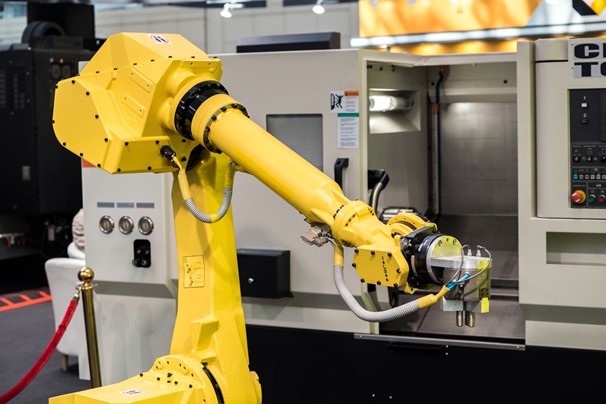
Articulated Robots
These are the most common types of robots used industrially. They contain rotary joints commonly known as axes. Some articulated robots are simple two-axis structures, while some are complex structures having 10 or more axes. All robotic axes in these robots offer additional degrees of freedom to ensure independent motions of such robots.
The enhanced range of motion and flexibility of articulated robots make them ideal for handling various workpieces, regardless of size. Some of the typical applications of these robots include:
- Arc welding
- Material handling
- Part transfer and packaging
- Assembly
- Machine loading
SCARA Robots
Selective Compliance Articulated Robot Arm (SCARA) is a four-axis robot designed to handle high-speed and repetitive operations. These robots work like human arms but with greater speed and precision. They also offer compact footprints to help them handle low payloads.
Their swiftness and efficiency help to lower costs and improve productivity while ensuring the safety of workers. SCARA robots are mainly used for:
- Assembly operations
- Pick and place
- Machining
- Packaging
- Inspections
Delta Robots
These are parallel-type industrial robots used in high-speed applications in the manufacturing industry. Their name comes from their unique upside-down triangular shoes. They are often mounted on top work areas, which are usually conveyors that move products down production lines.
This unique configuration and mechanical design give delta robots significant advantages over other robots. Common applications that use the strength of delta robots include:
- Assembly
- Disassembly
- Packaging
- Pick and place
- Sorting
Gantry or Cartesian Robots
These linear industrial robots work on three axes using the X, Y, and Z Cartesian Coordinate system. Gantry robots are popular options because their configurations are highly flexible. You can easily adjust the robot’s precision, size, speed, and stroke length.
Cartesian robots are larger with a higher range and payload. Therefore, they are suitable for working with workpieces heavier than average. Some of their applications include:
- Assembly
- Loading and unloading
- Material handling
- Pick and place systems
- Fastening and screw driving
- Packaging
- Cutting – Laser & Waterjet
Are Robotics Commonly Used for CNC Machining?
Several companies continue implementing CNC robotics due to its increased efficiency and other benefits. These benefits include:
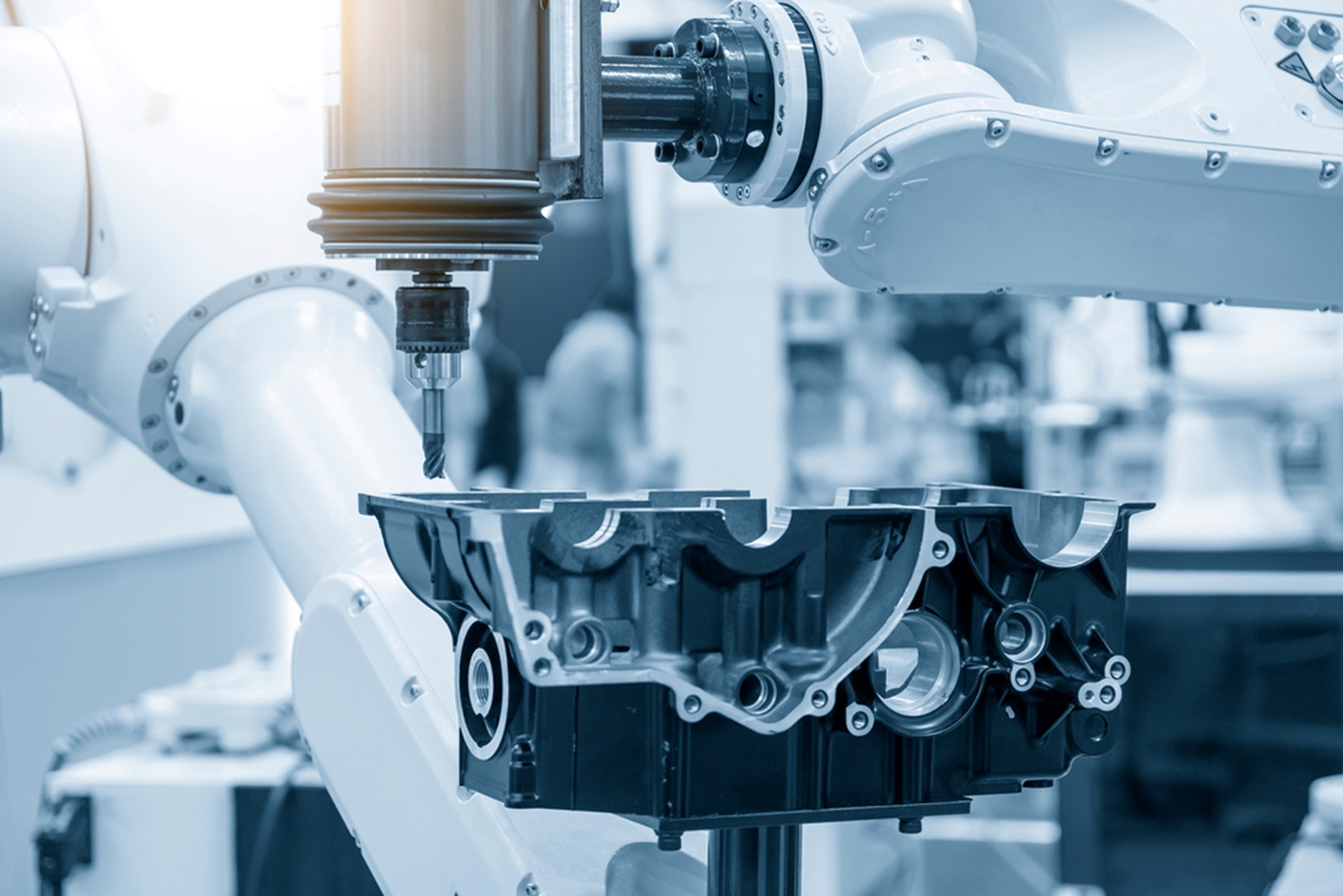
Fast Production Speed
Robots can be quicker than humans in some operations but slower in other processes. However, these machines are highly consistent. They can grab, load, and unload at the same speed for a long time.
In the past, the absence of a skilled operator may hinder the production process. However, a CNC robot can work efficiently and uninterrupted on computer programs. This hastens the speed of production, ensuring products get to market faster.
High Manufacturing Precision
Robotics loaders are programmed to ensure accurate positioning in every step. This includes picking up the workpiece, loading it into the CNC machine, placing it on the unloading table, etc. A robotic arm can reach +/-1 mm accuracy during loading and unloading operations.
Smooth Surface Finish
It is quite difficult to get machines to create the perfect surface roughness. However, CNC machining works perfectly with robots to create the best interactions with workpieces and provide appropriate surface finishes.
Perform Multiple Tasks
The ability to multitask with CNC robots is another great advantage that manufacturers leverage. As the CNC machines are milling, drilling, or lathing, the robotic arms can do other operations at the same time. It could be loading the next machine, packing the already fabricated products, or checking their quality.
Differences Between CNC Machines and CNC Robotics
Asides from the operations they can perform, these two technologies have various quality and performance differences. Let’s break them down by comparing five vital features:
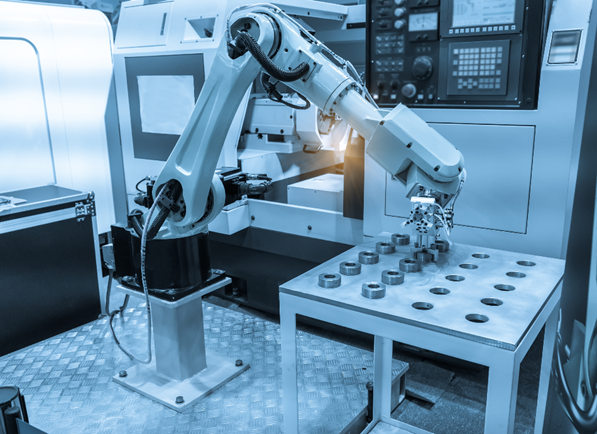
1. Accuracy
Machining precision or accuracy is one of the top properties used to determine the performance of any machine. Robot accuracies have improved over the past few years, with industrial robots reaching between 0.1 and 0.2 mm precision.
On the other hand, high-end CNC machines can reach a precision of between 0.02 mm to 0.05 mm. Swiss lathe machines have an accuracy of up to +/-0.0002 mm. Since the accuracy of robots often depends on calibration, the robotics industry focuses more on repeatability.
2. Versatility
A big advantage of robots is their increased versatility. They allow you to move easily from one task to another and perform various tasks simultaneously. While CNC machines can adequately perform specific tasks like milling, drilling, turning, etc., CNC robotics can do all these operations.
These robots can also move along different complex paths. CNC machines often have three or four degrees of freedom which is usually enough for many machining operations. However, it can be quite restrictive. Industrial robots provide a way out, with some having more than six degrees of freedom. As a result, you can machine basically any shape you wish.
3. Rigidity
The rigidity of machine tools often influences their accuracy. Tools with low rigidity tend to move when they encounter hard materials, causing inaccurate cuts. Robots have lower rigidity than traditional CNC machine tools, with their stiffness lower than 1 Newton per micrometer. On the other hand, CNC machines have a rigidity of over 50 Newtons per micrometer.
Robotic machining easily handles softer materials like plastic and wood. Although it can handle materials like steel and aluminum, there may be a backlash in the motors. This may decrease the accuracy of the resulting component.
4. Workspace
Although there are CNC machines with impressive workspace sizes, CNC robots often have larger workspaces. Medium-sized industrial robots typically have working envelopes of up to 7 cubic meters. Robots also allow easy addition of an external axis to extend their workspaces further.
5. Affordability
Both robots and CNC machines can be expensive. However, robotics has some distinct advantages over these machine tools — their versatility and large workspace. They can complete several operations on objects of practically any shape, size, and complexity. As a result, they offer more value for a less cost.
Will CNC Robotics Replace CNC Machines?
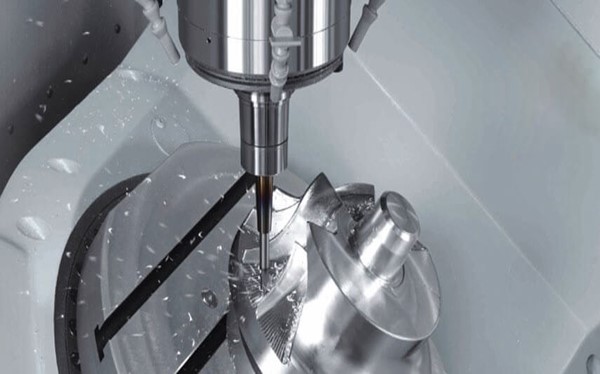
Despite the various offerings of CNC manufacturing robotics, they cannot yet match the precision and speed of modern CNC machines. Robots are highly versatile and can be adapted to perform various functions. However, CNC machines are more specialized in fabricating specific types of components.
Moreover, robots cannot yet match the speed and accuracy of CNC milling machines and Swiss lathe machining systems. Their low rigidity or stiffness also proves to be a major setback as it lowers the degree of accuracy they can reach with hard materials.
Although they continue to grow in popularity, we must acknowledge that CNC robotics may never completely replace CNC machines. However, several companies now combine both systems to work in harmony and improve productivity. As robots handle complex automation tasks, CNC machines carry out repetitive machining tasks.
RapidDirect CNC Machining Services for Your Robotic Parts
CNC machining is a great technology for custom robotic applications. However, the manufacturing process can only be as good as the manufacturing company. Therefore, you must work with a reliable manufacturing company with qualified technicians, engineers, and CNC machine operators. RapidDirect offers you all these at competitive rates.
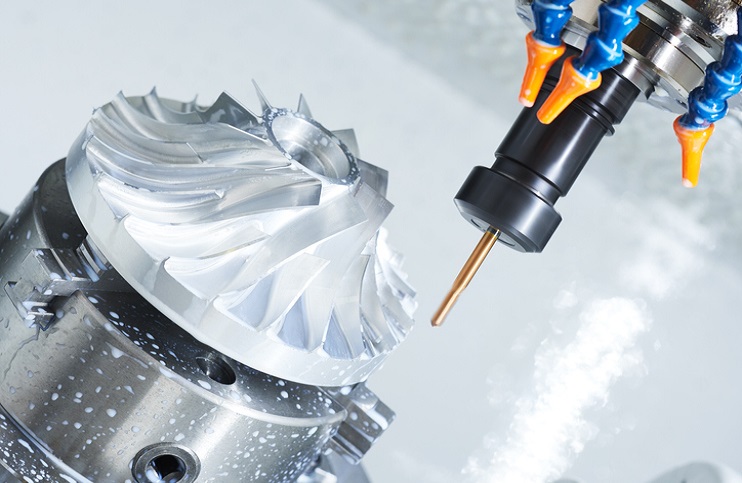
Our CNC machining services ensure the efficient manufacture of precision robotic parts. Our strong team of vetted engineers and professional project managers will work with you to ensure every part meets your specification. In addition, every part goes through our quality control and quality assurance processes to ensure high-quality results.
Upload your design file on our online platform today to get instant quotations. You will also get an automated DFM analysis report to improve your design for machinability and cost-effectiveness.
Conclusion
CNC robotics is an innovative technology in the manufacturing industry. As CNC machines help manufacture robots for your applications, combining CNC machines and robots also helps achieve outstanding results in parts fabrication. We have discussed the advantages of both technologies and their various differences and overlaps.
Creating robotic parts requires technical expertise and experience. Thus, it is crucial to get the services of a reliable manufacturing partner for the best results. Contact RapidDirect now for cost-effective CNC machining of robot parts.


